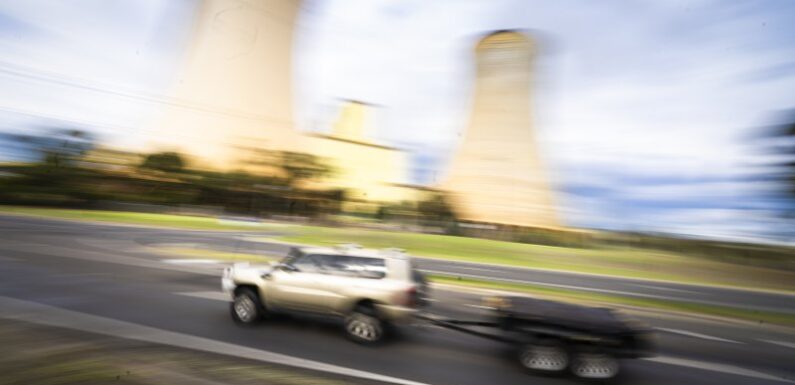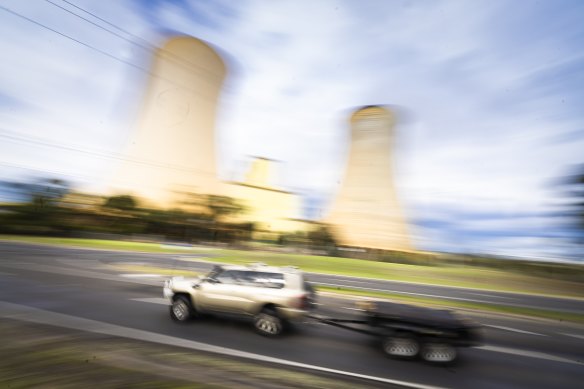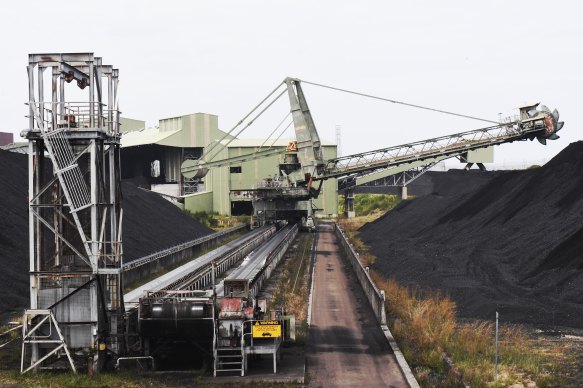
Save articles for later
Add articles to your saved list and come back to them any time.
A second secret government deal was done this week to help keep an ageing coal-fired power plant running as states worry that the pace of their shift to renewables raises the risk of blackouts.
But despite the cost to taxpayers – which is undisclosed but could run to hundreds of millions of dollars a year – the deals merely ensure the plants don’t close earlier than already planned.
In Victoria, AGL will close Loy Yang A by 2035, a decade earlier than expected.Credit: Eamon Gallagher
What deals have been done?
In Victoria, AGL will close Loy Yang A by 2035, a decade earlier than expected, and EnergyAustralia has brought forward Yallourn’s closure by four years to mid-2028.
The state government this week signed a binding agreement with AGL, after striking a similar deal with EnergyAustralia in 2021, to guarantee these coal plants remain operational until these dates, but refuses to disclose the terms of the deals and how much they could cost taxpayers.
Victorian Energy Minister Lily D’Ambrosio has said the Yallourn deal is to “secure transition to net zero for Victorians”, and not motivated by propping up coal.
AGL said this week its deal on Loy Yang would keep the plant operating in the event of adverse market conditions, like falling retail power prices, and D’Ambrosio said it would ensure adequate electricity supply as more renewables are built.
In NSW, Origin Energy plans to bring forward the retirement of Eraring – Australia’s largest coal-fired power station – by seven years to as early as August 2025.
This masthead revealed during the week that a NSW government-commissioned review of the state’s power grid recommended a deal be struck with Origin to extend its life beyond 2025. Industry experts estimate prolonging Eraring’s operations could cost between $200 million and $400 million a year.
The government’s response to the review will be released by the end of the month but NSW Premier Chris Minns has previously indicated he is open to extending its life.
Why are states worried about early coal closures?
NSW and Victoria have set ambitious emissions reduction goals and are banking on the rapid phase-out of fossil fuels to achieve the bulk of their climate targets.
NSW has a target to halve emissions by 2030 and reach net zero by 2050. To achieve this, it wants to reach 12 gigawatts of clean energy generation by 2030 – 45 per cent of the state’s total power generation capacity.
Victoria is aiming to cut its emissions by 75-80 per cent by 2035, and reach net zero by 2045. This is being backed by a target to boost renewable energy to 95 per cent of the grid by 2035.
But both governments are worried the pace of change may force coal plants to close before enough renewables are ready to fill the gap.
In NSW, Origin Energy plans to bring forward the retirement of Eraring – Australia’s largest coal-fired power station – by seven years to as early as August 2025.Credit: Nick Moir
“This [government deals] is about taking out insurance, and if you want to take out insurance, it costs you money,” Grattan Institute climate change and energy program director Tony Wood said.
“It’s providing a higher degree of confidence or certainty that we’re not going to have blackouts.”
Why can’t coal pay its own way?
Coal still generates about two-thirds of the grid’s electricity, but that is changing fast. In the final three months of 2022, renewables accounted for 40 per cent of average generation for the first time.
Cheaper renewable energy from wind and solar farms is undercutting fossil fuels’ business model and coal plants’ profitability is being hammered. No new coal plants are being developed and experts say new projects are economically unviable.
The Liddell coal plant in NSW closed this year and at least another eight of the 15 coal-fired generators remaining on Australia’s eastern seaboard are due to shut within the next 12 years.
How do these government energy deals work?
The short answer is: we don’t know. Victoria has cited commercial-in-confidence and refused to disclose the terms of its deals with AGL and EnergyAustralia.
It’s possible the deals supplement the profits of EnergyAustralia and AGL to keep the coal plants running, ensuring a certain volume of power is sent into the grid right up until their closure dates.
Alternatively, the deals could be to ensure that plants are kept in good condition, even if they are used less and less. This is so they can be cranked up in periods of low wind and high cloud cover, which reduce renewables’ input, and also include periods of high electricity demand such as during a heatwave.
Wood suggested a third option where government funding could kick in during an emergency – for example, when a unit explodes at a coal plant – to help bring power generation back up to capacity.
However, he is critical of the Victorian government’s refusal to publish the terms of its deals.
“The government could say: ‘We think this is worth doing because we’re worried about possible blackouts’,” Wood said.
“We shouldn’t have these sorts of deals being done confidentially because this is a market and these companies participate in that market and giving individual organisations a deal that not everybody can either see or knows.”
Cut through the noise of federal politics with news, views and expert analysis from Jacqueline Maley. Subscribers can sign up to our weekly Inside Politics newsletter here.
Most Viewed in Politics
From our partners
Source: Read Full Article

